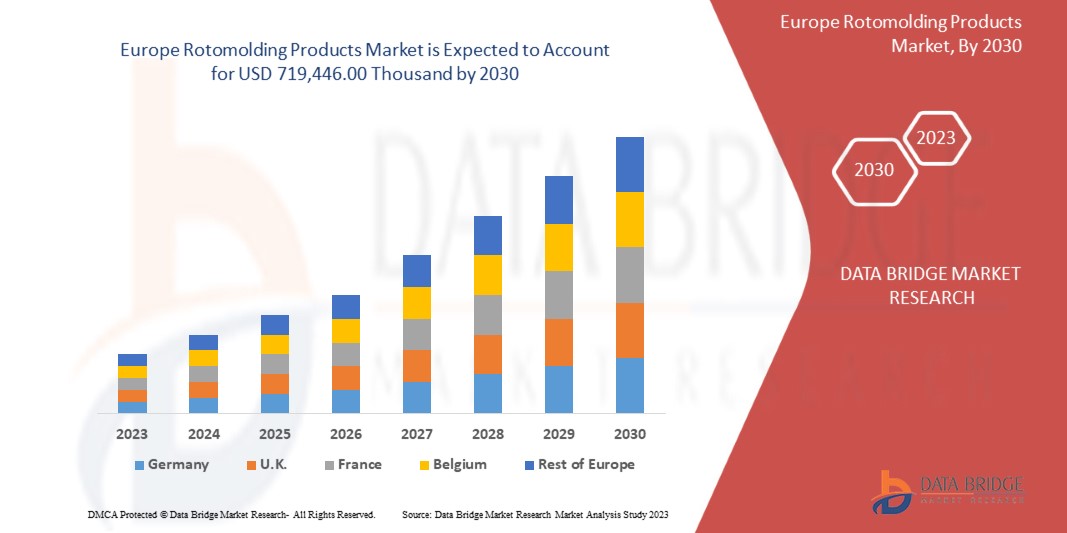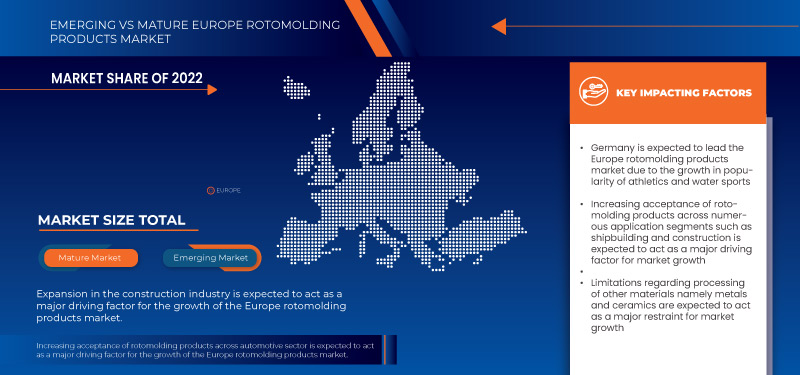Europe Rotomolding Products Market, By Product (Polycarbonate, Polyethylene, Polyurethane, PVC, Nylon, Polypropylene, and Others), Machining (Clamshell Machine, Shuttle Machine, Vertical or Rotational Machine, Carousel Machine, Swing Arm Machine, and Others), Application (Packaging, Agriculture, Industrial, Building & Construction, Consumer Goods, Automotive, Furniture, Marine, and Others) - Industry Trends and Forecast to 2030.
Europe Rotomolding Products Market Analysis and Size
The Europe rotomolding products market is being driven by the growth in the popularity of athletics and water sports. In addition, improvement in the shipbuilding industry is an important driver for the Asia-Pacific rotomolding products market. Moreover, the demand for rotomolding is increasing and manufacturers are now more focused and involved in the new product launch, promotions, awards, certification, and event participation in the market. However, excessive energy consumption and government regulations are expected to pose a challenge to market growth which may restrain the market growth.
Data Bridge Market Research analyses that the Europe rotomolding products market is expected to reach the value of USD 719,446.00 thousand by 2030, at a CAGR of 5.9% during the forecast period.
|
Report Metric
|
Details
|
|
Forecast Period
|
2023 to 2030
|
|
Base Year
|
2022
|
|
Historic Years
|
2021 (Customizable to 2015 - 2020)
|
|
Quantitative Units
|
Revenue in Thousand, Volumes in Units, and Pricing in USD
|
|
Segments Covered
|
Product (Polycarbonate, Polyethylene, Polyurethane, PVC, Nylon, Polypropylene, and Others), Machining (Clamshell Machine, Shuttle Machine, Vertical or Rotational Machine, Carousel Machine, Swing Arm Machine, and Others), Application (Packaging, Agriculture, Industrial, Building & Construction, Consumer Goods, Automotive, Furniture, Marine, and Others)
|
|
Countries Covered
|
Germany, Russia, France, Italy, U.K., Spain, Netherlands, Switzerland, Portugal, Belgium, and Rest of Europe
|
|
Market Players Covered
|
Rotoplast S.A.S., K. K. Nag Pvt. Ltd, FIBERTECH PLASTICS, Top Rotomolding Technology Co., Ltd., Yantai Fangda Rotational Molding Co., Ltd, Rotovia, Carris Pipes & Tubes Private Limited, Starplast S.r.l., PartnerPlast, ROTOMADE, Comos Corporation Co., Ltd, Rototek Limited, Tank Holding Corp., Sherman Roto Tank, Dutchland Plastics, Ocean Plastic Intertrade Co., Ltd., Ningbo Fly Plastic Co., Ltd., Changzhou Treering Plastics Co., ltd, and Myers Industries among others.
|
Market Definition
Rotomolding is a production process to form hollow parts of limitless size. This is a cost-effective method to produce large plastic parts. Resins are added into a mold that’s heated and rotated slowly, both vertically and horizontally. The simultaneous heating and rotation distribute and fuses the resin on the inner surfaces of the mold. The result is a product that contains seamless parts with a uniform wall thickness with more material in corners to absorb shocks and stresses where they occur most.
Europe Rotomolding Products Market Dynamics
This section deals with understanding the market drivers, advantages, opportunities, restraints, and challenges. All of this is discussed in detail below:
Drivers:
- Rising acceptance of rotomolded products such as containers and pallets in material handling and packaging applications
Material handling and packaging is among the five interconnected logistical roles that contribute significantly to logistics. The transportation, storage, control, and protection of materials, products, and packaged items during the manufacturing, distribution, and disposal processes are all part of material handling. Packaging serves a crucial purpose in enclosing materials and goods for distribution and transportation. They are important to improve customer service, minimize costs, and lower the chance of accidents and damage. The products manufactured through rotomolding technology offer affordable, safe, and durable solutions for material handling and packaging applications in various industries. They too have a high load bearing capacity because of their seamless, one-part design. Rotationally molded components are also a better alternative to conventional steel parts. Rotational molding is the ideal process for producing parts and components that may be utilized for collecting, storing, or moving nearly any substance due to its lower weight, improved corrosion resistance, and joint-free manufacture.
- Positive outlook toward the construction sector
The construction sector is associated with the building, repair, renovation, and maintenance of infrastructures. The construction industry contributes to the nation's socioeconomic development and economic growth. The construction industry generates activity and employment in other areas of the economy such as manufacturing, logistics, trade, and financial services. Population growth, growing urbanization, housing market, and infrastructure development are the key drivers of the construction industry.
The construction industry has the potential to be a major driving force in the expansion of rotomolded products. Rotomolded products have a wide range of applications in building construction projects such as water storage tanks and septic tanks among others. Moreover, products such as barricades and traffic cones that are used in the construction of roads and highways are also manufactured through rotomolding technology. Such products are durable, corrosion resistant, and require low maintenance which makes them ideal for infrastructure applications. Moreover, due to the light weight of products such as barricades and traffic cones, they are easy to carry which leads to lower fuel costs for the end user. In addition to it, they are easy to transport and relocate when compared to other products made from materials such as metal. The growing focus on developing efficient and long-lasting infrastructure adds up to the application growth of rotomolded products in the construction sector.
RESTRAINTS/ CHALLENGES
- Limitation regarding the processing of other materials namely metals and ceramics
Rotomolding technology is used to process thermoplastic polymeric materials like polyethylene and polypropylene. Moreover, the raw material used in the formation of rotomolding products be easily converted from granules to fine powder and should have high thermal stability. This limits the material selection to only poly-based resins in the formation of rotomolded products. The high thermal stability requirement leads to the high cost of raw materials and the expense of grinding material into powder to rise.
Although rotomolding offers various advantages when plastic based products are processed, however, it faces restraints while processing other materials such as metals and ceramics. They have high melting points compared to polymers, therefore offering a disadvantage because metal and ceramics require high temperatures. Ceramics and metals too have high structural strength and weight bearing capability that is less seen in rotomolded plastics. The metals and ceramics too have high heat resistance and thermal conductivity, therefore used in industrial applications where heat and thermal resistant properties are required. Hence, the inability to process materials such as metals and ceramics through rotomolding technology limits the growth of the Asia-Pacific rotomolding products market.
- Stringent rules and regulations aimed for polymers processing
There are various stringent rules and regulations imposed by various government organizations and international authorities related to the polymers that are used in the rotomolding process. These rules, regulations, and standards are made so that the industries follow them to ensure the health and safety of workers and consumers. A few of the regulations related to the polymers used for the production of rotomolding products are as follows:
OPPORTUNITIES
- Possibility of inclusion of new printing and labeling technologies
Over time, new label demands from customers and changing market dynamics will influence the choice of printed label type and new label technological developments. The packaging industry and its customers are constantly working to reduce the weight of product packaging, either by employing smaller rigid containers made of metal, glass, or plastic or by transitioning to flexible plastic formats. Labeling is essential for the manufacturing process. Labels can be used for product identification, warehouse labeling, and tracking things along the supply chain. Labels also help to boost consumer satisfaction by providing correct information about a product or service. Manufacturers ensure that end users, such as customers, may make educated purchasing decisions by properly identifying a product or service with labels.
- Increasing Access to Bio-Based Polymers
Bio-based polymers are polymers that are produced from sustainable resources such as agricultural waste, plant-based feedstock, or biodegradable materials. They have numerous environmental benefits that consist of low usage of fossil fuels, less production of plastic waste, and a low carbon footprint. The use of such polymers will also help to overcome regulations set up by the government authorities over polymers such as polyethylene and polypropylene. Moreover, consumers are getting aware of the side effects of plastics, therefore there has been an increase in consumer shift towards environmentally friendly polymers.
Europe Rotomolding Products Market Scope
The Europe rotomolding products market is categorized into three notable segments, by product, machining, and application. The growth amongst these segments will help you analyze major growth segments in the industries and provide the users with a valuable market overview and market insights to help them make strategic decisions for identifying core market applications.
Product
- Polyethylene
- Polypropylene
- PVC
- Polycarbonate
- Nylon
- Polyurethane
- Others
On the basis of product, the market is segmented into polycarbonate, polyethylene, elastomers, polyurethane, PVC, nylon, polypropylene, and others.
Machining
- Clamshell Machine
- Shuttle Machine
- Vertical or Rotational Machine
- Carousel Machine
- Swing Arm Machine
- Others
On the basis of the machining, the market is segmented into clamshell machine, shuttle machine, vertical or rotational machine, carousel machine, swing arm machine, and others.
Application
- Packaging
- Agriculture
- Industrial
- Building & Construction
- Consumer Goods
- Automotive
- Furniture
- Marine
- Others
On the basis of application, the market is segmented into packaging, agriculture, industrial, building & construction, consumer goods, automotive, furniture, marine, and others.
Europe Rotomolding Products Market Regional Analysis/Insights
The Europe rotomolding products market is analyzed and market size insights and trends are provided by country, product, machining, and application as referenced above.
The countries covered in the Europe rotomolding products market report are Germany, France, Italy, Spain, U.K., Russia, Switzerland, Portugal, Belgium, Netherlands, and Rest of Europe.
Germany is expected to dominate Europe region due to the rise in the adoption of the molding technique because of its inexpensiveness as the molds do not have to withstand pressure acts as one of the major factors driving the growth of the Europe rotomolding products market. However, the requirement of high cycle time and limited raw material selection may restrict the growth of the market.
The country section of the report also provides individual market impacting factors and changes in market regulation that impact the current and future trends of the market. Data points like down-stream and upstream value chain analysis, technical trends, and porter's five forces analysis, case studies are some of the pointers used to forecast the market scenario for individual countries. Also, the presence and availability of Europe brands and the challenges faced due to large or scarce competition from local and domestic brands, the impact of domestic tariffs, and trade routes are considered while providing forecast analysis of the country data.
Competitive Landscape and Europe Rotomolding Products Market Share Analysis
The Europe rotomolding products market competitive landscape provides details by competitors. Details included are company overview, company financials, revenue generated, market potential, investment in research and development, new market initiatives, Europe presence, production sites and facilities, production capacities, company strengths and weaknesses, product launch, product width and breadth, and application dominance. The above data points provided are only related to the companies focus on the Europe rotomolding products market.
Some of the major players operating in the Europe rotomolding products market are Rotoplast S.A.S., K. K. Nag Pvt. Ltd, FIBERTECH PLASTICS, Top Rotomolding Technology Co., Ltd., Yantai Fangda Rotational Molding Co., Ltd, Rotovia, Carris Pipes & Tubes Private Limited, Starplast S.r.l., PartnerPlast, ROTOMADE, Comos Corporation Co., Ltd, Rototek Limited, Tank Holding Corp., Sherman Roto Tank, Dutchland Plastics, Ocean Plastic Intertrade Co., Ltd., Ningbo Fly Plastic Co., Ltd., Changzhou Treering Plastics Co., ltd, and Myers Industries among others.
SKU-



